
Number 583 October 2019 Edited by Robin Densem
HADAS DIARY – LECTURE AND EVENTS PROGRAMME 2019
Lectures start at 7.45 for 8.00pm (unless otherwise stated) in the Drawing Room, Avenue House, 17 East End Road, Finchley N3 3QE. Buses 82, 143, 326 & 460 pass close by, & it is five to ten minutes’ walk from Finchley Central Stn (Northern Line). Tea/coffee & biscuits follow the talk.
Tuesday 8th October 2019: Andersons and Ack: The 20th Century Conflict Archaeology of London. Andy Brockman.
Abstract: The archaeology of modern conflict is one of the newest and fastest moving disciplines in archaeology. A status which is only likely to be enhanced as the two World Wars of the twentieth century pass beyond living memory.
This talk will offer a number of case studies illustrating the conflict archaeology of Greater London, including sites on London’s World War Two anti invasion stop line B, shown in the 2007 Time Team programme “Blitzkrieg on Shooters Hill,” and one of London’s first anti aircraft gun sites
built in 1915 to engage German Zeppelin raids. While examining some of the special challenges of conflict archaeology, particularly those of safety and the ethics of dealing with sometimes difficult or traumatic subjects, it will also suggest how this is a field of archaeological research where local
archaeological groups and heritage projects have a significant role to play in discovering and understanding the conflict archaeology of their communities.
Biographical: Andy Brockman has a MA in archaeology from Birkbeck College and directed the excavation of the anti aircraft gun site at Eaglesfield Park, and a survey of the former POW Camp 1020, both on Shooters Hill. A regular contributor to Britain at War magazine and other
publications, he has also appeared on Channel 4’s Time Team and conducted research for, as well as appearing in the Channel 5 documentary What the Dambusters did Next
Tuesday 12th November 2019: Shene and Syon: a royal and monastic landscape revealed by Bob Cowie.
Sunday 1st December 2019 Christmas Party at Avenue House, 12/30pm – 4pm. The application form will be in November newsletter, with the menu which will be a Christmas lunch, with alternatives. £30 per head.
Tuesday 14th January 2020 at 2.30pm
Ian Jones
Shelters to Shrapnel, surviving traces of Enfield At War, 1939-1945
Tuesday 11th February 2020. The Dorothy Newbury Memorial Lecture
Jon Cotton Prehistory in London – some Problems, Progress and Potential
Birdoswald: A photo from 1929 and a recent visit to the Roman fort on
Hadrian’s Wall – Robin Densem
Hadrian’s Wall is a long way from our HADAS homelands in Hendon and Barnet. But this article may encourage you to visit, I hope so. I visited the Wall in June 2019 to take the photos at figs 8-11, 13, and 15-22, to illustrate some of what can be seen. Limitations on space in this issue spared you
my writing many words: the article is mainly pictorial.
There is much information on the internet, including at https://www.englishheritage.org.uk/visit/places/hadrians-wall/hadrians-wall-history-and-stories/history/sources/ and at https://www.english-heritage.org.uk/visit/places/hadrians-wall/hadrians-wall-history-andstories/
history/
Fig 1 is a beauty and is an example of some of the 19th century interest in the Wall.
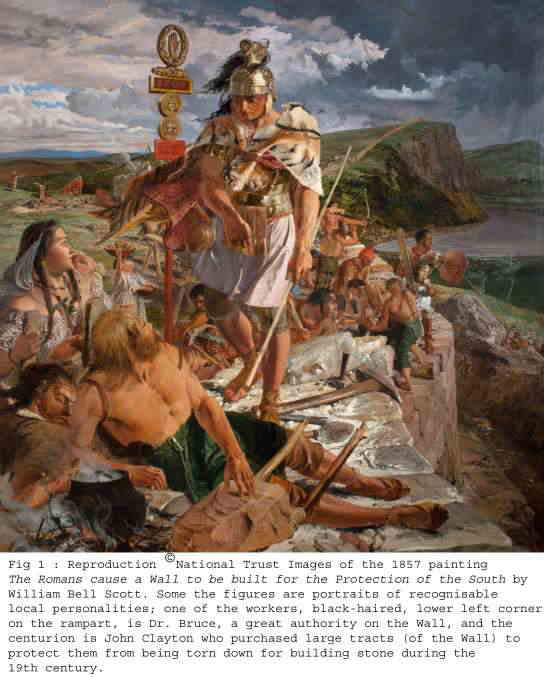
In Autumn 2004 Harvey Sheldon and I took a group to visit the Wall, including the Roman fort at Birdoswald. I was overcome with the beauty of the nearby River Irthing as we crossed to reach a turret on the Wall on the far side of the river. And, giving talks on the development of archaeology
for Harvey’s MA Archaeology course I began to use the famous 1929 photograph of the early stages of an archaeological excavation at Birdoswald in 1929 (fig 5) as it seems to encapsulate the early days of modern archaeological investigation, along with some social history – the contrast between the archaeological ‘toffs’ and the workers. The photograph features in many archaeology books and re-ignited my interest in Birdoswald. There is a marvellous account in Wilmott 2001 of the taking of the photograph in 1929 and the sudden realisation the next day that some of the people had been standing on Roman inscriptions re-used as floor slabs in the Roman barracks!
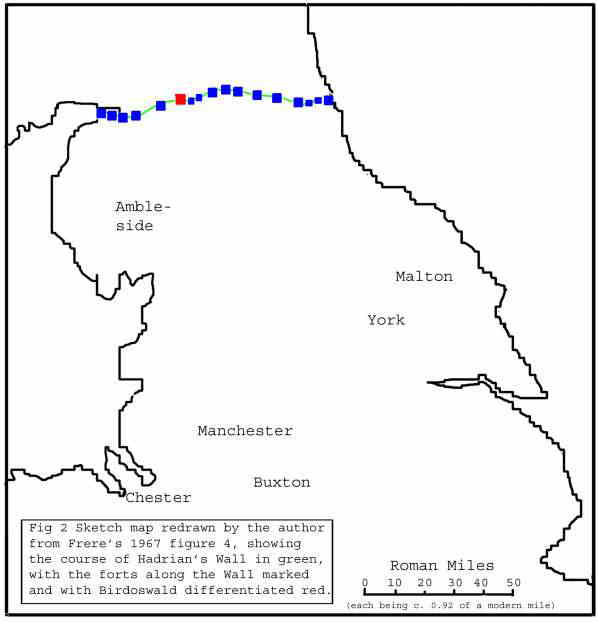
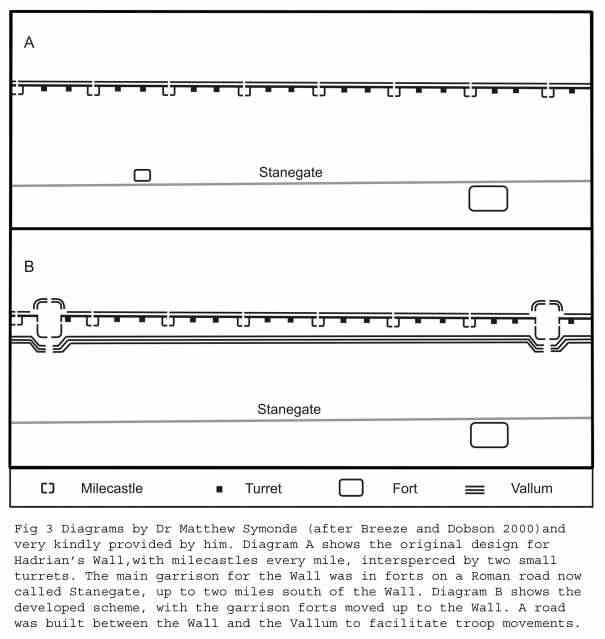
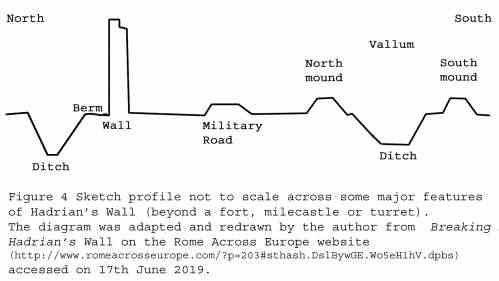
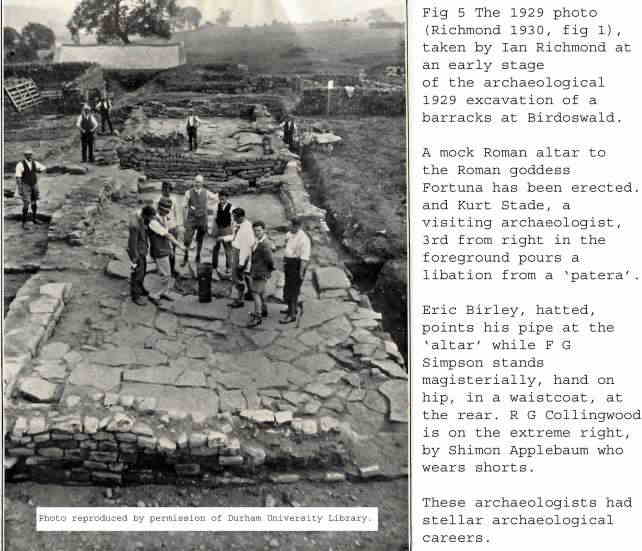
The location of the 1929 excavation is shown at fig 308 of Wilmott (ed) 2009
https://historicengland.org.uk/images-books/publications/hadrians-wall/hadrianswall chap6/
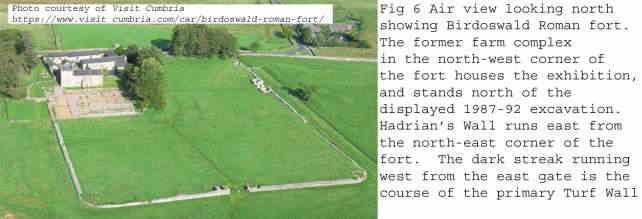
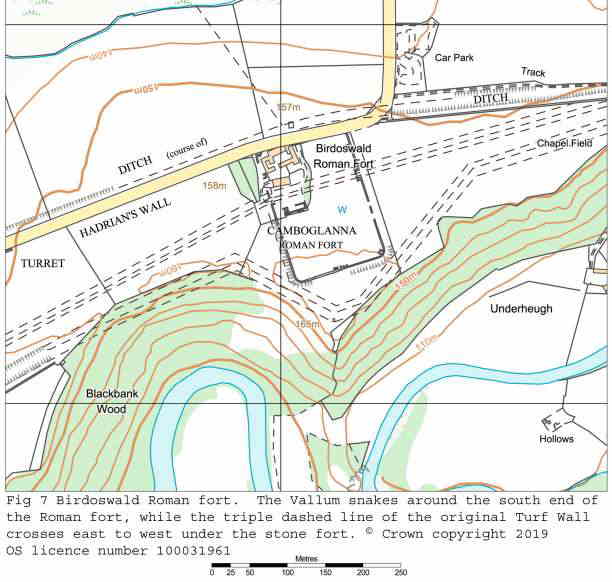
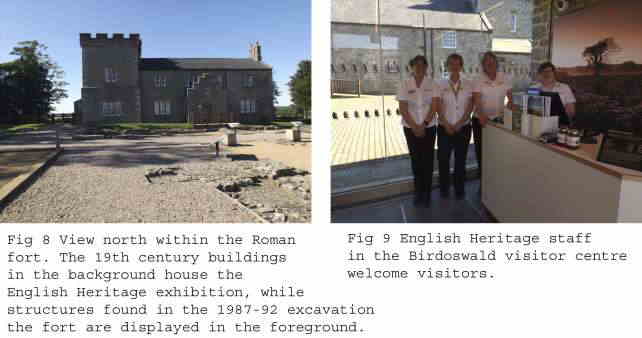

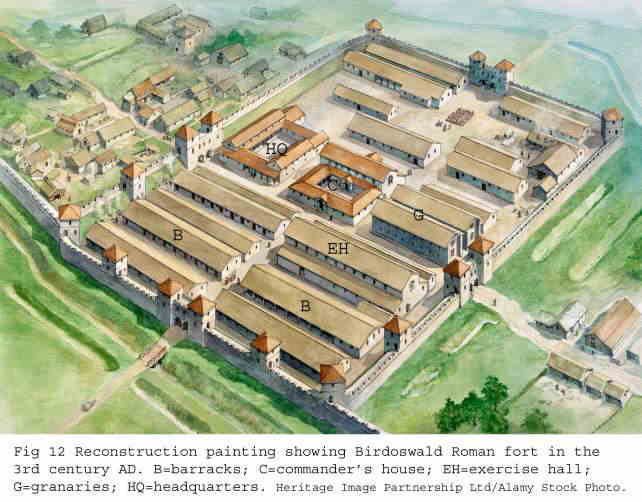


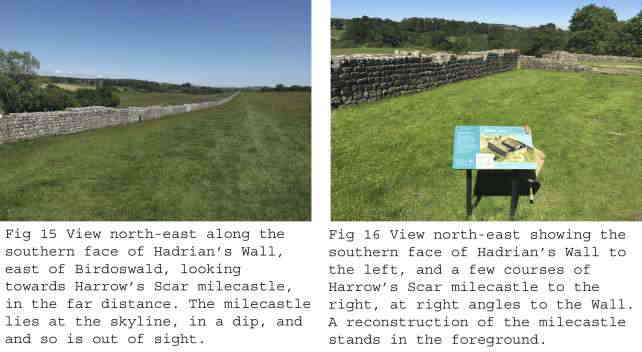
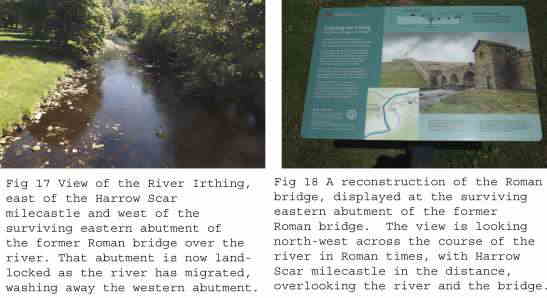
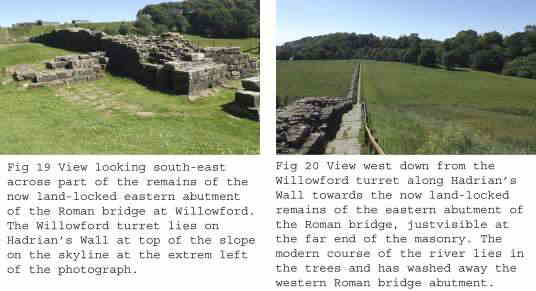
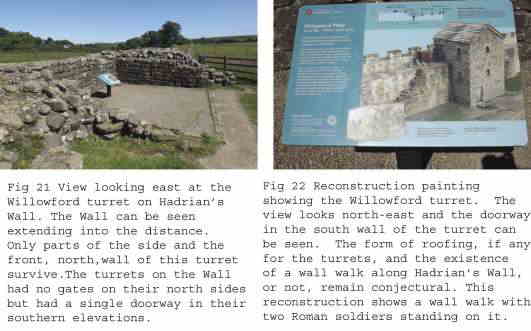
Acknowledgements
I am grateful for help from the English Heritage staff at Birdoswald; and for other help from Megan Evans, Dr Andrew Gardner, Dr Christopher Gilley, Professor Simon James, Rob Partridge, Harvey Sheldon, Dr Matthew Symonds, Colin Theakston, and Tony Wilmott. Errors are mine.
Bibliography
Breeze, David J and Dobson, Brian 2000 Hadrian’s Wall. London: Penguin Books Limited
English Heritage History of Hadrian’s Wall https://www.englishheritage.
org.uk/visit/places/hadrians-wall/hadrians-wall-history-and-stories/history/ accessed 25th July 2019
Frere, S S 1967 Britannia: a history of Roman Britain. London: Routledge & Kegan Paul
Richmond, I A 1930 “The University Excavations on Hadrian’s Wall”, The Durham University Journal, Vol. 26, No. 5, pp. 305-311
Symonds, Matthew 2017 Protecting the Roman Empire: Fortlets, Frontiers, and the Quest for Post-Conquest Security. Cambridge: Cambridge University Press
Wilmott, Tony 1997 Birdoswald, Excavations of a Roman fort on Hadrian’s Wall and its successor settlements: 1987-92. English Heritage: London
https://archaeologydataservice.ac.uk/archiveDSarchiveDownload?t=arch-1416-
1/dissemination/pdf/9781848021365_ALL.pdf accessed 1st June 2019
Wilmott, Tony 2001 Birdoswald Roman Fort: 1800 Years on Hadrian’s Wall. Tempus: Stroud
Wilmott, Tony (ed) 2009 Hadrian’s Wall Archaeological Research by English Heritage 1976–2000
https://historicengland.org.uk/images-books/publications/hadrians-wall/ accessed 25th July 2019
Ted Sammes Clay Pipe Collection – Part 2 Andy Simpson
Many of these ‘back garden’ finds are well away from other known archaeological find spots, so I have attempted to put them in roughly geographical groups.
As mentioned on Part One in the August 2019 HADAS newsletter (newsletter number 581), these are all recorded as ‘unstratified’ and there is rarely any details of finder or date.
Those wanting full details of mouthpiece type and bowl rim milling and finish – ‘bottered or cut? ‘can refer to the fully completed MOLA clay pipe recording sheets held in the ‘Ted Sammes Pipe Collection’ folder now in the HADAS archive.
We start with finds spots roughly associated with the main Edgware Road, moving north – south;
BROCKLEY HILL
Two found during fieldwalking in the winter of 1977/78 at this well-known Roman occupation / seasonal pottery kiln site on the A5/Watling Street north of Edgware.
Three bowls were recorded, all with makers’ marks on the sides of the spurs, leading to that familiar Sunday morning cry of ‘Relief, moulded, side of spur’ (RMSS)
Complete bowl, AO25 1770-1770 Mark I-(illegible)
Bottom of bowl and stem fragment AO29, 1840-1880 spur mark JH with (illegible) London on stem,
Complete bowl, AO33, post 1840, wheatsheaf design either side of bowl, shield design on spur, with ‘SULL 53’ (Sulloniacae 1953) site code inked on stem, so presumably a VERY old find from the 1953-4 excavations by the Sulloniacae Excavation Committee in the area published in the
contemporary LAMAS transactions.
COLINDALE
Penn Court, Annesley Avenue NW9
This short, mainly residential road links the Edgware Road with Colindale Avenue, with Penn Court flats near the junction with the latter opposite the Chandos Arms pub on its street corner site. An interesting location to find an English Civil War period clay pipe bowl of type AO10, 1640-1660
and four stem fragments of possibly similar date. No trace of a maker’s mark. Not on Sammes master list. A note with the pipe fragments records that they were found approximately nine inches down in the subsoil within an area above three square feet, in the week ending 18 July 1976 – the
infamous ‘summer of ‘76’ – before heatwaves became the norm, with the added comment ‘I’m sure that the rest is down there.’
STAPLES CORNER
Further HADAS archives that have only just come to light after many years’ storage off site indicate that near that glorious jumble of concrete and bridges where the A5 Edgware Road meets the A406 North Circular south of West Hendon Broadway and the Welsh Harp, two HADAS members making a weekly inspection of road works in March 1972 found a whole layer of clay pipe fragments, nearly 1100 in all, of which just six Victorian pipe bowls, all of type AO29, 1840- 1880, and an oval stem/tip fragment now remain in the archive.
Two of the bowls had the familiar Ribbed Wheatsheaf seams, ‘RWSS’, one combined with a thorn design, one of just thorn design, and one plain bowl fragment. Another had a ‘flanged’ spur and another a noticeable forward spur. Not on Sammes master list.
An exhibition caption in the rediscovered archive records that the pipes were all of late 19th/early 20th century date and were probably fairings – for blowing bubbles, not smoking.
The find-spot was part of the fairground beside the Lower Welsh Harp public house, rebuilt in 1858 as the centre of his pleasure gardens and again in 1938, which was demolished in 1971 to make way for the southern extension of the M1 motorway at this point, to which end the Staples Corner
flyover had already been completed in 1965.
https://pubwiki.co.uk/Middlesex/Hendon/OldWelshHarpTavern.shtml
The collection includes a b/w photograph of the find spot – the embankment adjoining the former West Hendon Police Station, (now a Jewish School), below a large advertising hoarding.
FINCHLEY AREA
30 Arden Road, between A504 Hendon Lane and A598 Regents Park Road, N3 Single bowl and stem, type AO5, 1610-1640, incised mark on side of heel ?I No milling. – Sammes List 131
50 Basing Way (Off East End Road) N3 A selection of fragments;
Thee broken fragments of bowl too small to identify; 15 stem fragments of 5-6mm diameter, 13 of 7-9mm diameter and 6 of 8-10mm diameter – Offcentre bore may suggest an earlier date.
One bowl of type AO30, 1850 – 1910, with scallop and rope decoration around the bowl and rope decoration around the top. Two lugs at base of bowl for stand. Sammes Number 99
One bowl possibly AO33, post 1840, with wheatsheaves along the bowl seams, front and back. Also has ’Rope’ decoration around top of rim and 8-part scalloping around the bowl.
East End Road, Finchley Two bowls; One part bowl fragment type AO4? 1610-1640 One complete bowl and part stem type AO25, 1700 – 1770, one side noticeably burnt. Sammes No 82.
Avenue House, East End Road
One complete bowl, part burnt, type AO5, 1610-1640, Full milling to bowl edge. Sammes No 79.
One part bowl type AO27, 1780 – 1810 with part of stem. Side of spur mark MC. Sammes No 80.
One fragment of bowl with basket design. Sammes No 83.
One stem fragment Sammes No 81, orange-brown in colour.
One stem fragment relief marked Andrews Highgate along the stem.
William Andrews of Highgate, pipemaker, is recorded in 1823 and 1828 and probably working before and after these dates as well – several bowls and a stem of his were found at the HADAS Church Terrace, Hendon excavations in 1973-74.
HENDON
Over 50 years on, we are STILL finding items from the Church End Farm excavations recorded some years ago in the HADAS publication ‘The Last Hendon Farm’
Sammes List CFM 30 is another one of these – an unmarked bowl of type AO25, 1700 – 1770, finely burnished with a cut top and marked with trench/context details CEF64 K2 30, suggesting it is from the main farmhouse site, on the west side of the west wall area. The August 1969 work on the site of the former Mount Pleasant and The Retreat terraces in the Hendon Church End area soon reached natural glacial gravelly sand at a depth of around two feet where the ground had not previously been cultivated. Surviving material in the HADAS archive recorded in April 2016 includes a quantity of clay pipe from the Mount Pleasant trenches.
In one trench (in grid L5) in the garden behind Mount Pleasant, – once a row of seven small cottages built around 1870 – lying some 50ft north of the former Chequers pub, was found a small York stone paved back yard, each being some 2 inches square and 3 inches deep, possibly with a
step down through a thin brick cross-wall into a red-tiled area, and beneath this heavily pebbled brown earth dump containing broken pottery and the stems of 18th-19th century clay pipe – 33 of which remain in the HADAS archive .
A trench in the front garden (O2) produced Victorian pottery similar to that at the nearby Peacock’s Yard, drainage pipes and a well-smoked clay pipe bowl and part of stem of form AO30, 1850-1910, marked W. TINGEY HAMPSTEAD on the stem. Sammes List 78
Also from this front garden trench were; Fragment of bowl, ribbed decoration, nineteenth century, marked O2 (1) Sammes List 92
Fragment of decorated stem and spur marked WA with wheatsheaf decoration, AO27, 1780 – 1820,
Marked with trench/context O2 (2) Sammes List 93
Short length of stem with partial makers’ lettering Tingey Hampstead in relief on both sides of stem Marked with trench/context O2 (2) Sammes List 94
Victorian pottery and clay pipe was also found throughout Trenches one/J3 and two/J5 in this area west of L5, including Staffs. creamware and Brownware, and ‘modern blue and White, plus iron and bone. These trenches featured well-worked dark loamy garden/cultivated soil, the area in 1753 being fields owned by John Coles.
The partial HADAS archive retained eleven pipe stem fragments and two bowl fragments from Trench J3 and seven stems and two bowl fragments from J5, the latter also yielding a single intact clay pipe bowl type AO33 with Irish Harp decoration dated post-1840 Sammes List 96
Other pipes from the site were identified during analysis of the separate Ted Sammes curated Clay pipe archive in 2019 were;
Complete bowl, AO25, 1700-1770 Marked with rear garden trench/context L5 (2) Sammes List 77
Plus another bowl.and stem fragment of similar type with relief spur mark WH Sammes List 95
Decorated bowl and length of stem, AO30, 1850-1910 Wheatsheaf decoration around top of bowl. Marked with trench/context J5 (1) Sammes List 91
There is also a post-1840 bowl, type AO40,
A further trench was opened, then rapidly closed, when a wartime Anderson air raid shelter was the only item found.
Trench 02 yielded garden soil on natural, electric cable, four lengths of field drain in one corner running NW/SE some 22 inches below the modern garden surface, and a gas pipe. The circular field drain lengths of 4in diameter/3in bore/11.5-12in long included one of buff-coloured fabric as well as three of the usual red fabric and this and one of the others were retained as samples; they contained little evidence of silting. The straight and well-made pipes were each laid on one notably flattened edge. This trench yielded large quantities of clay pipe – 61 stem fragments remain in the HADAS archive, plus a well ‘chewed’ mouthpiece, 20 small fragments of pipe bowl and four more complete bowls, type AO30, dated 1850-1910, which links well with the construction of the houses in the area around 1870.
A similar trench in the front garden of the former The Retreat – once a row of four cottages also built around 1870 south of the Mount Pleasant row ‘produced nothing of interest’ There have been several investigations in the presumed area of the former medieval manor house of Hendon. It is believed to have been built around 1325/6 as the Abbot of Westminster’s country retreat, being rebuilt around 1550 and again in the 1720s, when named Hendon Place. Renamed Tenterden Hall, and after use as a boy’s preparatory school, it was demolished c.1934 to make way for the present Cedars Close.
The first archaeological investigations recorded on the site were those by HADAS in 1969, noted in the HADAS newsletter for October 1969.
Resistivity surveying and excavations at Westhorpe Tenterden Grove (a large nineteenth-century house with surrounding grounds off Finchley Lane) – TQ2354 8962, SMR 081979 revealed a bed of gravel approximately nine inches below the surface. Resting on this were found sherds of
17th century pottery and clay pipe stems, together with an 18th century pipe bowl. After the preliminary surveys in August and the weekend of 1-2 November 1969 noted above. seven 10 foot square trenches were opened at Easter weekend, 27-30 March 1970 on the basis of the survey results;
Numerous sherds of pottery (including Bellarmine/Bartmann stoneware jug sherds of 16th/17th century date) were found, also roofing tiles, nails and clay pipes, two of which , dated 1640-1660, bear the initials R.B – see list below. All the finds were again resting on a gravel surface, in which was discovered a post hole and small areas of burnt material.
There are also a number of clay pipe fragments; analysis in 2019 of those identified from the separately curated Ted Sammes clay pipe archive, all marked ‘TG’ include the following;
Sammes List
102 Part Bowl, Form AO10, 1640-1660, Relief Marked RB on heel
103 Damaged bowl, Form AO10 1640-60, also marked RB as above.
104 Unmarked bowl, Form AO10, 1640-60.
105 Unmarked bowl, Form AO11, 1640-1670
106 Unmarked bowl, damaged rim. Form AO15, 1660-1680
107 Unmarked bowl, damaged rim. Form AO15, 1660 – 1680
108 Unmarked bowl, damaged rim. Form possibly AO20, 1680-1710
Two other bowls assumed to be from this site are one damaged bowl, possibly Form AO9 or AO10, 1640-60, and one part bowl possibly of Form AO22, 1680-1710.
Ted Sammes photographed the substantial two-story Victorian villa named Westhorpe during the 1970 excavation when it was in an advanced state of dereliction and almost roofless.
To be continued…
AN EXHIBITION, A BOOK, AND AN EXHIBTION IN A MUSEUM
Hot Peascods exhibition! – Guildhall Library’s outdoor exhibition explores street food through the ages from 1-16th October
This free exhibition in Guildhall Yard, EC2 brings together rarely seen images of London’s street food and street hawkers from the 16th century to the 19th century. The exhibition explains how selling street food in the capital, probably, since Roman times, was often the only option for some
people who could not find alternative paid employment and used it as a stop gap until they found a better job. Sometimes requiring little more investment than a basket and the cost of the first batch of pies,
gingerbread or eels, it would keep some people out of the workhouse, while others fell into poverty and found that selling food on became their life’s occupation.
Medieval Londoners edited by Elizabeth A. New and Christian Steer will be published on 31st October and is to honour Caroline M. Barron, Emeritus Professor of the History of London at Royal Holloway, University of London, on her 80th birthday. Her remarkable career has revitalized the
way in which we consider London and its people. HADAS members may remember her excellent lecture in October 2016 on medieval women in London.
The rich evidence for the medieval city, including archaeological and documentary evidence, means that the study of London and its inhabitants remains a vibrant field. Medieval Londoners brings together archaeologists, historians, art-historians and literary scholars whose essays provide
glimpses of medieval Londoners in all their variety.
Published by University of London Press, 400 pp. Available from 31 October 2019 in print for £40.00, kindle and e-pub £32.00 and will be free Open Access pdf
Last supper in Pompeii – Ashmolean Museum, Oxford until 12th January 2020
This is an excellent exhibition which concentrates on the activities relating to food: eating and drinking but also the production and buying and selling of food and wine. There are over 400 objects which are well displayed. There are several sections which have projected backdrops which
give a good impression of the rooms in Pompeian houses. There is also a section on Roman Britain including some of the wooden writing tablets from the Bloomberg / Mithraeum site. It is advisable to buy a timed ticket as this is a popular exhibition – with an excellent catalogue for £20.00
OTHER SOCIETIES’ EVENTS Compiled by Eric Morgan
Weds 9 Oct 2pm – 3,30pm, Mill Hill Historical Society at Trinity Church, 100 The Broadway, London NW7 3T. Fiona Smith: Work of the Commonwealth War Graves Commission Visitors £2.
https://millhill-hs.org.uk/events/work-of-the-war-graves-commission/
Thurs 17 Oct 7.30pm – 9pm Camden History Society at Burgh House, New End Square, London NW3 1L. Cynthia Floud: What can Phyllis Ford’s Childhood tell Social Historians? Visitors £2.
http://www.camdenhistorysociety.org/events/2019/10/17/what-can-phyllis-fords-childhood-tellsocial- historians-a-talk-by-cynthia-floud
Mon 21 Oct 8.15pm Ruislip, Northwood & Eastcote Local History Society, at St Martin’s Church Hall, High Street, Ruislip at 8.15pmAGM followed by the Society’s Medieval Research Group: Medieval Ruislip. Visitors £2. https://rnelhs.btck.co.uk/Lectures
Sat 26 Oct Amateur Geological Society of North London, meeting at 2.30pm platform 1 of Canary Wharf station of the Docklands Light Railway for a walk led by Mike Howgate The Stones of Canary Wharf. Non-members £2. Do bring a hand lens. Book by contacting Mike Howgate 0208
882 2606, mobile number (for emergencies & on trips) 07913391063, email
mehowgate@hotmail.com . https://amgeosoc.wordpress.com/breaking-news-2/
Sat 2 Nov 10am to 4pm. Aldenham Transport Spectacular, held at Allum Manor House & Hall, 2 Allum Lane, Elstree WD6 3PJ. Admission £3.
Sat 2 Nov 10.30am – 4.30pm. Geologists’ Association Festival, including exhibitors from the world of geology, including fossil and mineral displays. University College London, Gower Street, London WC1 6BT. Free event https://geologistsassociation.org.uk/festival/
Sat 2 Nov 10.30am – 2.30pm Hornsey Historical Society Public Local History Surgery , held at Hornsey Historical Society, 136 Tottenham Ln, London N8 7EL. Telephone 07531866714 or email hornseyhistoricalsurgery@gmail.com in advance to book a half hour appointment and to let the Society know the advice and assistance you require.
Mon 4 Nov 2pm-3pm, British Film Posters – An Illustrated History: Sim Branaghan at Finchley Church End Library, Gateway House, 318-320 Regents Park Rd, Finchley, London N3 2LN. Free admission. https://www.barnet.gov.uk/sites/default/files/yol_barnet_libraries_a5_prog3_hg3_0.pdf
Weds 6 Nov 5.30 for 6pm – 8pm, Docklands History Group at Museum of London Docklands, West India Quay, (off Hertsmere Road) London E14 4AL. Robert Hampson: Conrad and the docks and the river. Visitors £2.. https://www.docklandshistorygroup.org.uk/page3.html
Thurs 7 Nov 2pm – 3pm Guildhall Library, Aldermanbury, London EC2V 7HH. Robert Stephenson: The Gruesome History of Bodysnatching. Free event but tickets to be booked in advance via Eventbrite https://www.eventbrite.co.uk/e/the-gruesome-history-of-bodysnatchingtickets- 66661064037
Thurs 7 Nov 8pm Pinner Local History Society, Pinner Village Hall, Chapel Lane Car Park, Pinner HA5 1AB. Pat Clarke: Mrs Marshall, Pinner’s Other Domestic Goddess. Visitors £3.
https://www.pinnerlhs.org.uk/programme16 –
Fri 8 Nov 7.30pm for 7,45pm Enfield Archaeological Society, Jubilee Hall, Parsonage Lane Enfield (close to Chase Side). Neil Pinchbeck: Flints and Mammoths: London N13. Visitors £1.50 https://www.enfarchsoc.org/lectures/
Weds 13 Nov 2pm -3.30pm. Mill Hill Historical Society at Trinity Church. 100 The Broadway, London NW7 3T. Dorell Dresseekie: An Act of Faith – The Story of The North London Hospice. Visitors £2. https://millhill-hs.org.uk/events/an-act-of-faith-the-story-of-the-north-london-hospice/
Weds 13 Nov 7.45pm 7.30pm for 8pm Hornsey Historical Society. Professor Ian Christie: The World’s First Film Studios? Putting R. W. Paul Back on the Map for his 150th Birthday: Visitors £2. https://hornseyhistorical.org.uk/talks/
Sat 16 Nov 10.30am – 4pm London and Middlesex Archaeological Society local history conference
In Sickness and in Health: The wellbeing of Londoners through history. Weston Theatre, Museum of London, 150 London Wall, London WC2Y 5HN. Various speakers, local society displays, refreshments. Tickets £12.50 if bought up to 31st October, thereafter £15.
http://www.lamas.org.uk/conferences/local-history.html
With thanks to this month’s contributors:, and Eric Morgan
Hendon and District Archaeological Society
Chairman: Don Cooper, 59 Potters Road, Barnet, Herts. EN5 5HS (020 8440 4350) e-mail: chairman@hadas.org.uk
Hon. Secretary: Jo Nelhams, 61 Potters Road Barnet EN5 5HS (020 8449 7076) e-mail: secretary@hadas.org.uk
Hon. Treasurer: Jim Nelhams, 61 Potters Road Barnet EN5 5HS (020 8449 7076) e-mail: treasurer@hadas.org.uk
Membership Sec: Stephen Brunning, Flat 22 Goodwin Court, 52 Church Hill Road, East Barnet EN4 8FH (020 8440 8421) e-mail: membership@hadas.org.uk
HADAS website: www.hadas.org.uk

